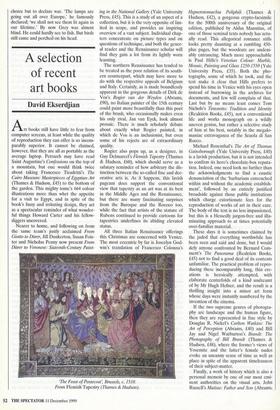A selection of recent art books
David Ekserdjian Art books still have little to fear from computer screens, at least while the quality of reproduction they can offer is so incom- parably superior. It cannot be claimed, however, that they are all as portable as the average laptop. Petrarch may have read Saint Augustine's Confessions on the top of a mountain, but one would think twice about taking Francesco Tiradritti's The Cairo Museum: Masterpieces of Egyptian Art (Thames & Hudson, £45) to the bottom of the garden. This mighty tome's 664 colour illustrations more than whet the appetite for a visit to Egypt, and in spite of the book's fussy and irritating design, they act as a spectacular reminder of what wonder- ful things Howard Carter and his fellow- diggers uncovered.
Nearer to home, and following on from the same team's justly acclaimed From Giotto to Diirer, Jill Dunkerton, Susan Fois- ter and Nicholas Penny now present From Darer to Veronese: Sixteenth-Century Paint-
ing in the National Gallery (Yale University Press, £45). This is a study of an aspect of a collection, but it is the very opposite of lim- ited in scope, and provides an inspiring overview of a vast subject. Individual chap- ters concentrate on picture types and on questions of technique, and both the gener- al reader and the Renaissance scholar will find they gain a lot from its lightly worn learning.
The northern Renaissance has tended to be treated as the poor relation of its south- ern counterpart, which may have more to do with the respective appeals of Belgium and Italy. Certainly, as is made boundlessly apparent in the gorgeous details of Dirk de Vos's Rogier van der Weyden (Abrams, £90), no Italian painter of the 15th century could paint more beautifully than this poet of the brush, who occasionally makes even his only rival, Jan van Eyck, look almost prosaic. There is much scholarly debate about exactly what Rogier painted, in which de Vos is an inclusionist, but even some of his rejects are of extraordinary quality.
Rogier also pops up, as a designer, in Guy Delmarcel's Flemish Tapestry (Thames & Hudson, £60), which should serve as a salutary reminder of how arbitrary the dis- tinction between the so-called fine and dec- orative arts is. As it happens, this lavish pageant does support the conventional view that tapestry as an art was at its best in the Middle Ages and the Renaissance, but there are many fascinating surprises from the Baroque and the Rococo too, while the fact that artists of the stature of Rubens continued to provide cartoons for tapestries Underlines its abiding elevated status.
All three Italian Renaissance offerings this Christmas are concerned with Venice. The most eccentric by far is Joscelyn God- win's' translation of Francesco Colonna's The Feast of Pentecost, Brussels, c. 1510. From Flemish Tapestry (Thames & Hudson). Hypnerotomachia Poliphili (Thames & Hudson, £42), a gorgeous crypto-facsimile for the 500th anniversary of the original edition, published by Aldus Manutius, of one of those seminal texts nobody has 'actu- ally read. This allegorical romance stills looks pretty daunting at a rambling 450- plus pages, but the woodcuts are undeni- ably entrancing. Much more approachable is Paul Hills's Venetian Colour: Marble, Mosaic, Painting and Glass 1250-1550 (Yale University Press, £35). Both the pho- tographs, some of which he took, and the text make it clear that Hills prefers to spend his time in Venice with his eyes open instead of burrowing in the archives for documents, and few will complain of that. Last but by no means least comes Tom Nichols's Tintoretto: Tradition and Identity (Reaktion Books, £45), not a conventional life and works monograph on a wildly uneven genius, but rather a selective study of him at his best, notably in the megalo- maniac extravaganza of the Scuola di San Rocco.
Michael Rosenthal's The Art of Thomas Gainsborough (Yale University Press, £40) is a lavish production, but it is not intended to confirm its hero's chocolate-box reputa- tion. Indeed, one need look no further than the acknowledgments to find a caustic denunciation of the 'barbarians entrenched within and without the academic establish- ment', followed by an entirely justified broadside against those public institutions which charge extortionate fees for the reproduction of works of art in their care. The body of the text is no less impassioned, but this is a blessedly jargon-free and illu- minating approach to at times potentially over-familiar material.
These days it is sometimes claimed by the jaded that everything worthwhile has been seen and said and done, but I would defy anyone confronted by Bernard Com- ment's The Panorama (Reaktion Books, £45) not to find a good deal of its contents unfamiliar. The practical problem of repro- ducing these incomparably long, thin cre- ations is heroically attempted, with elaborate centrefolds of a kind undreamt of by Mr Hugh Hefner, and the result is a thrilling insight into a minor art form whose days were instantly numbered by the invention of the cinema.
If the two supreme genres of photogra- phy are landscape and the human figure, then they are represented in fine style by Douglas R. Nickel's Carlton Watkins: The Art of Perception (Abrams, £40) and Bill Jay and Nigel Warburton's Brandt: The Photography of Bill Brandt (Thames & Hudson, £48), where the former's views of Yosemite and the latter's female nudes evoke an uncanny sense of time as well as place in spite of the apparent timelessness of their subject-matter.
Finally, a work of history which is also a personal memoir by one of our most emi- nent authorities on the visual arts. John Russell's Matisse: Father and Son (Abrams,
£25) is an account of relations between the great painter and his art-dealer son, in which the latter's relationships with the artists he showed are explored in fascinat- ing detail. The fact that Russell also knew many of these modern giants gives his book an unrepeatable ring of truth.



























































































 Previous page
Previous page